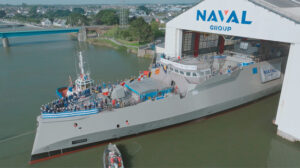Officially and on schedule, the big event for the Hellenic Armed Forces was the launching of the frigate HS Nearchos at the Naval Group shipyards in Lorient, France, last Thursday. However, in a surprise communications initiative by the government, the focus shifted from “Nearchos” and the other two Belh@rra (HS Kimon” and HS Formion) to another frigate, the fourth – as yet unchristened, though presumably to be named HS Themistocles.
The surprise and corresponding interest generated by Defence Minister Nikos Dendias – and especially from France, under the imposing shadow of HS Nearchos – shot even higher with the revelation that three of the four Belh@rra frigates will carry the MdCN (formerly known as SCALP Naval) cruise missiles as part of their arsenal.
Speaking from the podium of the event, which was organized by Naval Group at its premises, especially for the launch of the second Greek frigate, Mr. Dendias said that Greece will continue to participate in the Eurocorvette development program, briefly giving other important details of the government’s current and future actions and aiming to strengthen Greece’s arsenal, with the substantial modernisation and qualitative upgrading of the country’s defence assets. Moreover, the acquisition of Belh@rra is the first major action to renew the ageing Greek fleet, after 26 years of stagnation and a total absence of naval defence procurement.
The last addition to the Hellenic Navy’s (Navy) fleet was in 1998 with the frigate Salamis, which today is considered “old”, especially compared to a ship of FDI HN (Frégates de Défense et d’Intervention for the Hellenic Navy a.k.a. Belh@rra) specification. Indicatively, the addition to the fleet, apart from the weapons (8 surface-to-surface MdCN missiles, 76 mm Oto Melara forward cannon, 24 Aster 30 anti-aircraft/anti-ballistic missiles, 8 Exocet Block anti-ship missiles, four torpedoes etc.), each frigate has a number of sensors mounted on its PSIM, while the Sea Fire radar alone is said to be capable of detecting and tracking targets in a range of just under 450 km.
Nevertheless, the revelations of the Defence Minister in Lorian have given rise to a very specific and dominant mental image: four warships at the forefront of defence technology such as the futuristic and imposing-looking (albeit with 122 m. length are considered medium sized) digital frigates Belh@rra, in full operational readiness with the insignia of the Hellenic Navy, deter enemy threats before they even manifest themselves. For that is the Belh@rra’s almost incalculable symbolic asset: the SCALP Naval, the missiles that – if and when needed – have the capability to hit targets up to 1000 kilometers deep inland of a potential enemy.
In this light, even such a crucial milestone in the construction of the frigate HS Nearchos, such as its maiden sailing, was somehow overshadowed by Dendias’ announcements.

Battle tested
The SCALP Naval are 6.5 m long, 50 cm in diameter and 1,400 kg in weight, capable of reaching speeds of up to 800 km/h. The warhead of each missile carries an extremely high explosive charge weighing 300 kg, but their main advantage is their their trajectory can, thanks to a large number of sensors, be programmed and controlled with extreme precision. In the case of the Belh@rra, the Naval SCALP will be launched from the vertical A70 Sylver guided missile launcher at the front of the ship. Schematically, but absolutely essentially, with the Belh@rra quartet, plus the SCALP Naval on three of the four ships, the Hellenic Armed Forces’ combat effectiveness achieves a qualitative leap.
Of course, the naval (surface-to-surface) SCALP Naval are similar in philosophy to the airborne SCALP EG, which are included in the equipment of the also French-built Rafale fighter aircraft recently acquired by the Hellenic Air Force. These missiles have recently been used in real conditions by Ukraine against Russia in targeted attacks. In fact, the name SCALP Naval, although a registered trademark and likely to accompany these rockets forever in defence parlance, has been abandoned by the manufacturer, the French-British MBDA. Instead of SCALP Naval (acronym for Système de Croisière Conventionnel Autonome a Longue Portée – Long Range Naval Missile System), they are now called MdCN (Missile de Croisière Naval – Naval Long Range Rockets).
In Salamis
The whole project is based on the synergy between the Greek Navy and more than 10 Greek companies, which are contributing as external suppliers and partners to the completion of a literally mega project – and not just by domestic standards.
Significantly, Naval Group President Pierre-Eric Pomeguet, in his own address during the launching ceremony of the HS Nearchos, particularly thanked the 120 Greeks who are working closely with the shipyard at every stage of construction. According to information from Navy officials, the special requirements from the Greek side are the installation of certain sensors, in addition to those provided for in the Naval Group’s plans, in order to cover the needs of the Greek maritime space, given, of course, that the Navy does not operate, e.g, in oceanic waters, but mainly in the Aegean and Southeastern Mediterranean, in an area that will “suffocate” in case of tension, with a multitude of enemy air and naval targets and threats. Therefore, the Greek Belh@rra are co-designed by Greeks and French, offering ideas and models even to the French Navy for its own frigates. The cooperation between Greece and France, on a practical level, also involves the construction of sections (blocks) of the frigates at the Salamis Shipyards.
The cost
The formalisation of the immediate interest in acquiring the fourth Belh@rra was announced on Thursday by Mr Dendias. In reality, however, this particular addition has been the subject of constant and intense concern, almost from the very beginning of the planning for the purchase of ships of this type.
From a strategic point of view, the new Hellenic Navy “quartet” is considered to be indispensable by the operational reality itself in order to ensure that at least two vessels are available at all times for immediate execution of missions. It is understood, however, that the most serious source of concern for the government in acquiring the additional frigate was the financial aspect. In the end, both the Defence Minister and the Prime Minister, Kyriakos Mitsotakis, in their social media posts, assure that the extension of the Belh@rra program by one ship is on the basis that “the expenditure of the new purchase has been budgeted in a way that does not disturb our fiscal consistency. It has, however, been deemed necessary since the armouring of the homeland is a non-negotiable priority.”
Specific details on the cost of the fourth frigate, the general terms of the purchase and the expiration of the deadline (option) for extending the original order, as provided for in the original contract with the Naval Group, are not being made public.
In his remarks, the Defence Minister pointed out that the Belh@rra program, although modified, has been an important part of the “Agenda 2030” and is clearly included in the 12-year Long Term Defence Equipment Planning, which, he said, was presented to the Prime Minister and in the coming days the relevant Committee of the Greek Parliament will be briefed.
He also listed the government’s actions which, he said, “create an impregnable wall in the Aegean and a new reality” as follows:
– The four Belh@rra, the modernization programs of the MEKO frigates, the Roussen missile ships and the submarines
– The acquisition of four Island patrol vessels
– The future participation of Greece in the design and development of the new Constellation frigate.
– Participation in the Eurocorvette program
– The opening of negotiations for the acquisition of four new submarines.
– The promotion of a number of smaller but high operational value programs, etc.
Meanwhile, at the Naval Group’s shipyards in Lorian, an outside observer of the work has the feeling that the three frigates are one ship – just in a different phase of their construction: the HS Kimon at a very advanced stage, the HS Nearchos sailing but without the PSIM mast, its digital brain, yet in place, while the HS Formion has just begun to take on the shape of a frigate. The French builders are confident that the delivery deadlines – from autumn 2025 onwards – will be met in full, even if the “Themistocles” is added to the trio in the near future.
Ask me anything
Explore related questions





